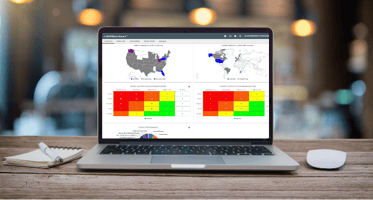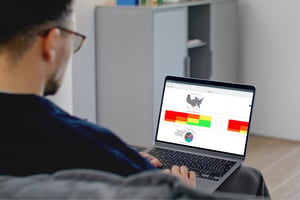The Lost Time Incident Rate (LTIR) provides EHS leaders with a standardized method for tracking the...
Busting Five Frequently Believed EHS Software Myths

For many Environmental, Health & Safety (EHS) teams, the thought of switching to a new platform brings up old frustrations. Safety and sustainability were once managed with paper and pen, then spreadsheets, and finally early versions of EHS software. Experienced EHS managers may still remember the expense and inconvenience associated with each transition. Even worse, some of those early solutions made compliance harder, not easier. If you’ve navigated past transitions, it’s easy to see how some EHS software myths persist.
Rooted in those long-past experiences, EHS software misperceptions are outdated and no longer applicable. Teams who are still clinging to them may be left holding onto tools that slow them down. The reality is that modern cloud SaaS EHS software is secure, fast to deploy, easy to customize, and built for real-world adoption. EHS leaders who stay current on evolving software trends are better equipped to make decisions that support stronger safety programs and free up time for proactive work.
The Five Most Common EHS Software Myths
- Difficult setup
- Rigid processes
- High cost
- Security concerns
- Poor adoption
Myth #1: “These systems are hard to set up and use.”
Why it’s believable: Once state of the art, on-premises software required long installations, heavy IT involvement, and expensive outside consultants to implement. Training often stretched over weeks, and the interfaces weren’t designed for ease of use. Leaders who lived through those projects often equate “new system” with disruption.
Today’s reality: Cloud-based EHS platforms require no local installation and far less hands-on IT work. Deployment can happen in days or weeks, with guided onboarding and ready-to-use templates that eliminate guesswork. Modern design standards put user experience first, with features like drag-and-drop form builders, one-click inspections, and built-in tutorials. Instead of taking teams offline, the goal is to help them start working in the system as quickly and smoothly as possible.
Myth #2: “Software is one-size-fits-all and won’t work for our unique processes.”
Why it's believable: Every EHS program has its own needs. A manufacturing plant tracks equipment inspections differently than a construction company tracks jobsite safety. In the past, software often forced organizations to change their workflows to match the system’s limitations, which could mean abandoning processes that already worked well and replacing them with new ones that didn’t fit.
Today’s reality: Modern EHS platforms are built to be flexible from the ground up. Configurable templates allow organizations to start with a framework and then adapt it to their specific internal requirements. Teams can create inspection checklists that mirror established procedures, adjust reporting fields, and build forms tailored to their industry, all without custom coding or developer involvement. With changes like UI enhancements arriving frequently and new AI features in the works, this flexibility will only increase in coming years.
This adaptability supports consistent standards across multiple sites or departments. One centralized platform supports the entire organization while looking and feeling just right for each team that uses it.
Myth #3: “SaaS EHS tools are too expensive and only for big companies.”
Why it's believable: This is one of the most pervasive EHS software myths. Earlier generations of enterprise software came with steep price tags for servers, licenses, integration costs, and ongoing maintenance fees. The math didn’t work for smaller teams. Even mid-sized organizations often decided to stick with spreadsheets to avoid over-investing.
Today’s reality: The shift to cloud delivery has changed the financial model for most EHS software providers. Subscription pricing means there’s no massive upfront spend on infrastructure. Hosting, updates, and support are included in the cost, and organizations can start small before expanding to more features or users.
Affordability is only part of the story. Modern EHS platforms can replace hours of manual data entry, paper chasing, and spreadsheet reconciliation with automated workflows. Those efficiency gains mean teams spend more time preventing incidents and less time shuffling paperwork, generating a return on investment that goes beyond the subscription fee.
Myth #4: “Keeping our EHS data on the cloud isn’t secure.”
Why it's believable: Safety and compliance records can contain sensitive information. Headlines about data breaches fuel the idea that storing those records in the cloud is inherently risky. Internally hosted systems left many EHS managers feeling like they had more control over security, even if resources to protect that data were limited.
Today’s reality: Top-tier cloud providers make security a core function, with investments in infrastructure and monitoring that far exceed what most companies can maintain on their own. This includes encryption for data in transit and at rest, advanced firewalls, intrusion detection, continuous monitoring, and regular third-party audits. Certifications such as SOC 2 and ISO 27001 provide independent verification of these safeguards.
Access control is also more granular than ever, allowing administrators to determine exactly who can view, edit, or export data. Automatic backups protect against hardware failures, and geographically redundant storage ensures availability even in the event of a local outage. When implemented correctly, not only is cloud hosting more secure than software hosted on site, but it can also do a better job protecting critical EHS data.
Myth #5: “Our team won’t adopt it. It’ll just add more work.”
Why it's believable: If a system feels like extra work, people will find ways around it. Many EHS pros have experienced tools that required double data entry or had confusing interfaces, leading to low staff engagement and wasted investment. Resistance is especially common if the frontline doesn’t see an immediate benefit.
Today’s reality: Times have changed! Modern EHS platforms are designed with the end user in mind. Mobile compatibility allows for inspections, incident reporting, and task updates in the field. Automated reminders reduce the need for managers to chase down overdue actions. QR code scanning can pull up the right checklist in seconds, eliminating extra navigation steps.
When a tool speeds up routine tasks and makes information easier to find, adoption becomes a natural outcome. In some organizations, the switch to a modern platform has turned safety tracking from a single-person job into a shared responsibility across teams, driving both participation and accountability.
Connecting the Dots: How the EHS-Dashboard™ Addresses These Myths
If any of these myths have held you back from exploring new technology, you’re not alone. Many EHS and sustainability leaders share the same concerns. The difference now is that solutions exist specifically to remove these barriers.
Developed and supported by industry insiders who know what it takes to succeed, the EHS-Dashboard™ was developed to reflect the realities described above:
- Fast setup, so that even a small team can configure their account and start logging data without waiting for a long, multi-week training course.
- Flexible design that supports custom checklists, forms, and reports.
- Drag and drop form builders and one-click forms that turn what used to be multi-step paperwork into a quick digital checkmark.
- Purpose-built with small EHS departments in mind, offering an intuitive, streamlined experience that doesn’t require a dedicated IT person to manage.
- Predictable costs with subscription pricing that scales as you grow.
- Secure hosting with encryption, backups, and compliance standards.
- User-friendly features like mobile access and automated workflows.
By directly addressing the concerns behind these EHS software myths, the EHS-Dashboard™ makes it possible for teams to focus on what matters most: keeping people safe, staying compliant, and building a strong culture of safety.
If you’re ready to see what that looks like for your organization, schedule a demo and explore how the EHS-Dashboard™ can work alongside you to protect your people, assets, and operations.
-1-1.png?width=50&name=Higher_Elevation_Software_copy-removebg-preview(1)-1-1.png)


